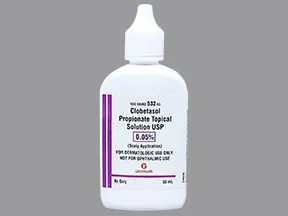
#Clobetasol topical free
plasma cortisol, and urinary free cortisol tests. This may be done by using the ACTH stimulation, A.M. Patients applying a topical steroid to a large surface area or to areas under occlusion should be evaluated periodically for evidence of HPA axis suppression. Manifestations of Cushing’s syndrome, hyperglycemia, and glucosuria can also be produced in some patients by systemic absorption of topical corticosteroids while on therapy. Systemic absorption of topical corticosteroids can produce reversible HPA axis suppression with the potential for glucocorticosteroid insufficiency after withdrawal from treatment. PRECAUTIONS GeneralĬlobetasol propionate cream should not be used in the treatment of rosacea or perioral dermatitis, and should not be used on the face, groin, or axillae. CONTRAINDICATIONSĬlobetasol propionate cream is contraindicated in those patients with a history of hypersensitivity to any of the components of the preparations. If no improvement is seen within 2 weeks, reassessment of the diagnosis may be necessary. Use in children under 12 years of age is not recommended.Īs with other highly active corticosteroids, therapy should be discontinued when control has been achieved. Treatment beyond 2 consecutive weeks is not recommended, and the total dosage should not exceed 50 g per week because of the potential for the drug to suppress the hypothalamic-pituitary-adrenal (HPA) axis. INDICATIONS AND USAGEĬlobetasol Propionate Cream, USP 0.05% is a super-high potency corticosteroid formulation indicated for the relief of the inflammatory and pruritic manifestations of corticosteroid responsive dermatoses. Studies performed with clobetasol propionate cream indicate that it is in the super-high range of potency as compared with other topical corticosteroids.
#Clobetasol topical skin
Inflammation and/or other disease processes in the skin may increase percutaneous absorption. Topical corticosteroids can be absorbed from normal intact skin. Occlusive dressings with hydrocortisone for up to 24 hours has not been demonstrated to increase penetration however, occlusion of hydrocortisone for 96 hours markedly enhances penetration. The extent of percutaneous absorption of topical corticosteroids is determined by many factors, including the vehicle and the integrity of the epidermal barrier. Arachidonic acid is released from membrane phospholipids by phospholipase A 2.

It is postulated that these proteins control the biosynthesis of potent mediators of inflammation such as prostaglandins and leukotrienes by inhibiting the release of their common precursor, arachidonic acid. However, corticosteroids are thought to act by the induction of phospholipase A 2 inhibitory proteins, collectively called lipocortins. The mechanism of the anti-inflammatory activity of the topical steroids, in general, is unclear. Like other topical corticosteroids, clobetasol propionate has anti-inflammatory, antipruritic, and vasoconstrictive properties. Related/similar drugs Tremfya, prednisone, doxycycline, methotrexate, triamcinolone, Humira, betamethasone topical CLINICAL PHARMACOLOGY


 0 kommentar(er)
0 kommentar(er)
